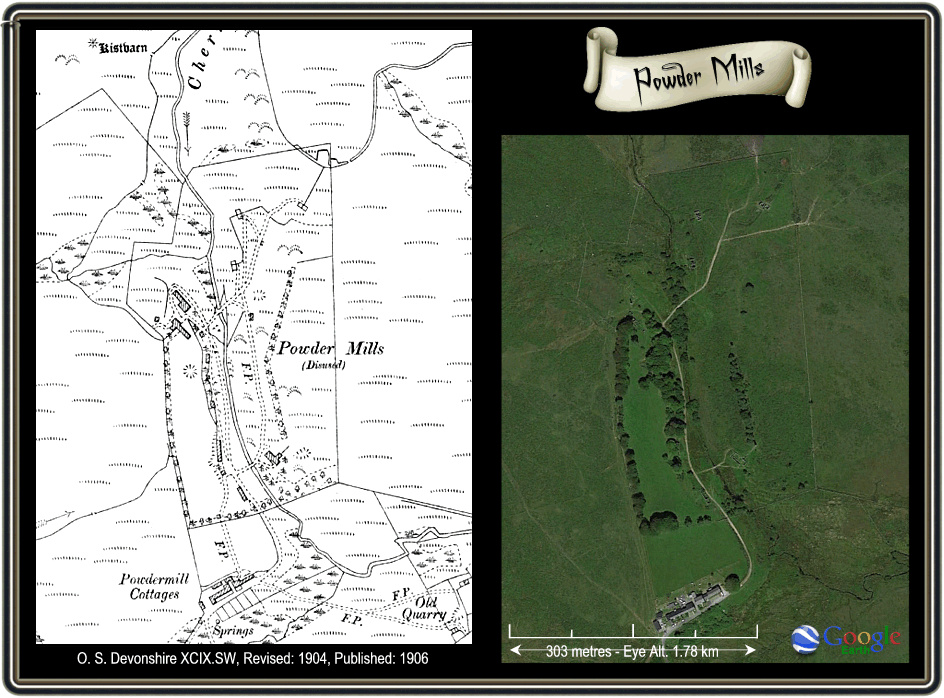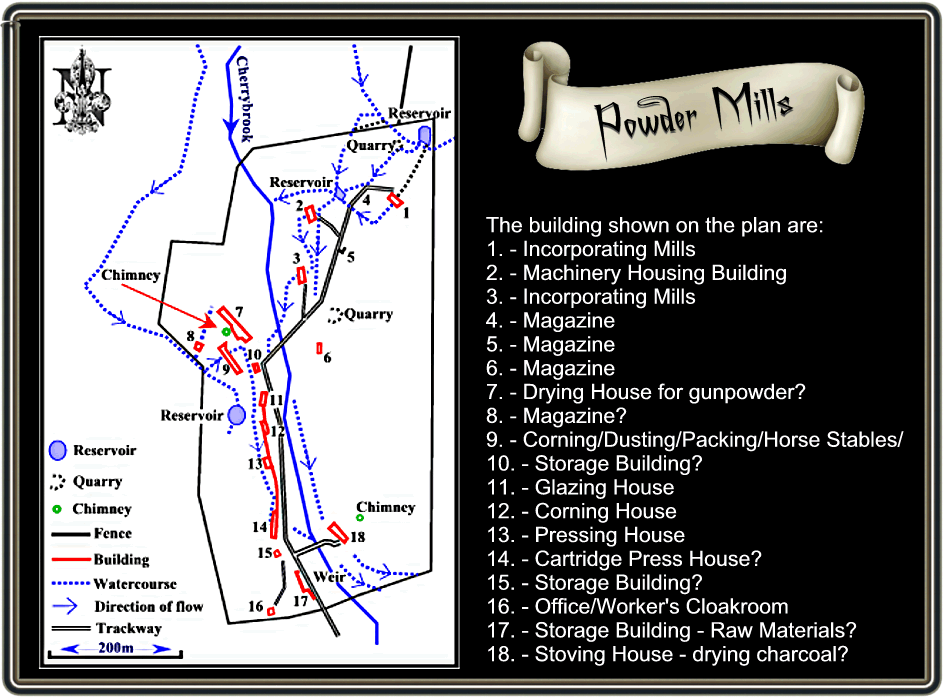
Drive down the B3212 and you will find another of Dartmoor’s ‘Little Gems’ in the shape of Powder Mills, today there is a signpost for a pottery but 160 odd years ago there would have been a busy industrial landscape. This was the site of a gunpowder making factory or mill. The remoteness of the place is the first indicator of what was being made here, clearly you would not build a gunpowder mill near any centre of inhabitation just in case of an accident. So the site of the mill is far enough removed to avoid any catastrophe should an accidental explosion take place.
But why a gunpowder factory in the middle of Dartmoor? One of the answers for this can be found a few miles up the road at the Birch tor mining complex, this and dozens like it all needed gunpowder or ‘blackpowder‘ as it was called for blasting the lode bearing rocks of the mines. In addition there were various quarries who also needed blackpowder for blasting rock such as Swell tor, Foggintor and Merrivale. During the 18th and early 19th centuries farmers were also using gunpowder to clear rocks from lands that were being enclosed, evidence of which can be seen by the ‘clearance cairns’ at the edges of the newtakes. So in terms of a viable market, this could be found locally and the blackpowder was in great demand.
In 1844, George Frean, a wealthy Alderman from Plymouth formed the Plymouth and Dartmoor Gunpowder Company. He applied to the Duchy for a licence to build the gunpowder mills on farmland belonging to Cherrybrook Farm. The location provided central access, remoteness and an available water supply from the nearby Cherrybrook which would provide a power source. It also had a good provision for the planting of a covering of alder trees which could be used for charcoal as well as providing a natural wind-break. Building work began in 1844 and was completed two years later in 1846 when production began. The estimated cost for the venture was over £12,000 with the mill complex covering a large area of well separated buildings.
It is suggested that Prince Albert took a personal interest in the project as was proven in 1848 when Frean was summoned to the Duchy to explain why he had leated water from the Cherrybrook without official permission. Unusually the required permission was speedily granted along with the approval of additional leats to take water from the nearby East Dart river.
The water system was for those days a very ‘environmentally friendly’ arrangement. There was a series of small reservoirs which took their water from the East Dart river. The water was then carried via a wooden launder to power three water wheels, excess water from the first wheel was fed to the second wheel, this was done via a network of channels and sluices. The excess from the second wheel went on to feed the third wheel and then it was returned to the Cherrybrook through a tailrace which also filtered out many of the absorbed impurities.
The blackpowder was made from a mixture of sulphur, ground saltpetre and charcoal. There were various grades of powder but a normal mix would consist of 75% saltpetre, 15% charcoal and 10% sulphur. The saltpetre was imported mainly from India whilst the sulphur came from the Vesuvius, Stromboli and Sicilian volcanic areas of Italy. The charcoal came from locally sourced burners and was made from alder, willow, juniper, dogwood and silver birch. Each ingredient was separately ground in a grinding mill and the required quantities were then mixed and blended in special barrels. This mixture was crushed, mixed and churned to form the crude blackpowder. Depending on how fine the powder needed to be the whole process could take up to 24 hours to complete. Once the powder had been incorporated it would finish up looking something like a ‘cake’ and was called the ‘ripe charge’. The charge would be stored for a short period and then compressed into 1″ slabs, initially this was done with hand presses but later technology saw the introduction of water powered hydraulic presses.
The slabs of ‘ripe charge; would be broken into granules by means of using a wooden mallet, again this was later replaced by water powered granulated machines. The grains would then be fed through a series of graduated sieves which initially was a manual task but later became mechanised. The grains were the ‘tumbled’ in gauze covered cylinders in order to collect any dust particles. The whole of this second process was called ‘corning’.
The ‘corned’ grains were then tumbled again often with the addition of graphite or black lead which would coat the grains this was known as ‘dusting’. The purpose of this was to give the powder a waterproof coating thus making the end product suitable for using in damp mines or quarries. The final process was to dry the gunpowder in trays, this was either done in the open-air or in rooms heated by ‘Gloom stoves’ and latterly by steam. Both of the artificial methods required a flue to draw away any sparks and fumes from the furnace and take them up a chimney.
Once the powder was dried it was packed in large oak barrels which sometimes would be clad with leather to avoid any possible spillage. The barrels would have been made on-site by the mills own coopers who it is estimated accounted for 20% of the workforce. The barrels would then be transported by horse and cart to various storage and distribution centres known as ‘magazines’. These were in Taviton, Ashburton, Newton Abbot, Exeter and Plymouth. From these centres the blackpowder would be sent to the various mines and quarries either by horse or cart or by rail.
The efficiency of the gunpowder was regularly checked by use of a ‘proving mortar’. This was a large mortar which would fire a 68lb shot over a measured distance, the calibration distance travelled would then indicate the strength of the powder. There is a fine example of such a mortar beside the driveway which leads down to the pottery.
The safety regulations at Powder Mills were stringent for obvious reasons. Only wooden and copper handed tools were used and all the workers that were involved in the mixing process had to wear leather aprons and soft soled boots. hob-nails were a big no-no. Some of the floors in the more ‘volatile’ areas were covered in tanned leather and all in all everything possible was done to reduce the risk of a spark igniting the powder. The walls of the buildings where the incorporation process took place were built of huge granite blocks many of them being 6ft long and 18″ wide this was to help contain any explosion should it occur. In contrast the roofs were made of a light wood and tar which meant they would be blown off in the event of an explosion as opposed to collapsing in on the workers.
The mill provided employment for people from all around the area with workers coming from Tavistock and Chagford, at times their numbers could reach over a hundred. Some lodged locally whilst others walked several miles each day to get to the mill. The people employed in the manufacture of the gunpowder were officially classed as ‘gunpowder makers’, in addition the mill employed blacksmiths, carpenters, wheelwrights, coopers and wagoners. In 1848 a new storehouse was built at Summerhill just to the west of Ashburton, the idea being that such a depot would save any customers from southern Dartmoor having to travel all the way to Powder Mills.
Following the invention of dynamite in 1867 and the development of gelignite and cordite the demand for blackpowder fell drastically. This also coincided with the decline in the tin and copper mining industry and eventually led to the closure of the powder mills in 1897. George Frean actually retired sometime between 1884 and 1885 when the mill was taken over by a Mr G. Williams.
The site then fell into decline with some of the buildings being used to house cattle. During WWII the site was occupied by around 3,000 American troops who used it as a training camp prior to the D-Day landings. There is one story which suggests that some enterprising soldiers decided that the proving mortar may come in useful in the forthcoming engagements and stole it. Fortunately it was spotted at Plymouth docks about to be loaded onto a ship and was rescued and returned to the mills.
Today the mill stands in ruins with only a row of cottages still in use. Documents show that at one time these cottages were occupied by the work’s manager and foreman, they were called Powdermill Cottages. The modern pottery was once used as a school and on Sundays as a chapel, however Harris, p.132 considers that there was a separate chapel. The plan below shows the layout of the complex in 1989:
On one occasion somebody noted the size of the workforce and realised that working at the mill would be thirsty work. An application was duly lodged to the Duchy for permission to open and inn, Frean however saw the potential dangers if alcohol was combined with gunpowder makers and so opposed the idea on safety grounds saying it would result in “idling and drunkenness,” – the application was refused.
One worker at the mills was Silas Sleep and each day he would eat his packed breakfast and dinner at the same time because if he got blown up he would go to his maker fully replenished. There also is an old story that some of the workers in the more volatile areas of the mill were provided with one legged stools to sit on. Should anyone fall asleep on the job they would then end up on the floor and vigilance would be restored. There are very few reports of explosions at the mill but in 1851 there was a tragic incident when; “One of the houses at the Dartmoor Powder Works took fire last week. One man was so much burnt that he died shortly after the accident; three other were also much injured, but they are doing well. The man who received the fatal injury has left a wife and five children. The next morning another part of the works was blown to atoms by an explosion.” Bell’s Weekly Messenger, July 19th, 1851. In the November of 1857 another explosion at Powder Mills severely injured two man. Following this in the December of 1857 a further two men, named Dodd and Hamlyn were killed in an explosion at the works, Gill, p.128 records that the damage was estimated at £500.
Not only was Mr. Frean and industrial entrepreneur but he was very much a caring employer and as far a agriculture goes somewhat of a visionary. He certainly brought much needed employment to the area and due to the nature of the work paid above the average wage. He provided comfortable cottages all of which were surrounded by a few acres of drained and fenced off land in which they could grow some crops. The mid 1800s was very much a time of agricultural innovation with some people suggesting that viable crops could be grown on Dartmoor. Although these ideas were met with scepticism in some quarters it seems Mr. Frean was all up for proving them wrong. A local newspaper report from 1845 explained how on a reporter’s visit to Powder Mills they bore witness to this fact. Near the Cherrybrook they saw a field of mangel worzels, in a adjoining field a crop of oats was growing along with a thriving crop of potatoes and cabbages. In the small field belonging to the cottages there were beds of carrots. Mr. Freans secret of success was; “By draining, shelter, and the application of artificial manures, the principal applied being animal manures, consisting of bone dust and guano.” So sure was Frean of his methods that he put up a wager that if a better acre of potatoes could be found in the district he would give as a prize an acre of his potatoes. The Western Times, September 6th, 1845.

Brunton, A. 1994 The Gun Powder Mills, Orchard Publications, Newton Abbot.
Harris, H. 1992 The Industrial Archaeology of Dartmoor, Peninsula Press, Newton Abbot (pp 128-133).
Hemery, E. 1983, High Dartmoor, Hale Pub., London (pp 435-437).
Gill, C. 1977 Dartmoor – A New Study, David & Charles, Newton Abbot.
Palmer, J. & Palmer, O. 1999 Powder Mills, Dartmoor Magazine No.55, Quay Publications, Brixham.
Pye, A. 1994 The Gunpowder Factory at Powdermills, Devon Archaeological Society, Stroud. (pp.221 – 239)

 Legendary Dartmoor The many aspects past and present of Dartmoor
Legendary Dartmoor The many aspects past and present of Dartmoor




Hello my name is Dr Drew Campbell. I have written a book due out soon on the powdermills and wondered if I could use your map of the site as it is much netty than mine – obviously you will be fully acknowledge- I have a number of references to your reach I’m the footnotes already.
All the best Drew
Hello,
My Great-grandparents, THE STEPHENS FAMILY, farmed Powdermills for many years, living in the main house with their son living in one of the cottages. I am wondering if anyone has any idea of what the main house is used for now. In addition if anyone has any information regarding that family I would be delighted to receive it. Living in Cambridgeshire now I am afraid I cannot get down to Devon to try to find out information for myself and having to rely on the internet.
With many thanks.
Hi, Bessie and Zacharia Stephens were also my great grandparents! My Uncle George lived in one of the cottages and Mabel in the big house. Their daughter Bessie was my grandma. How are we related?
Hi Shirley.
George and Dorothy Stephens were my Uncle and Aunt, and I have fond memories of childhood visits to Powdermills, rambling around the ruins, and of Auntie Dorothy’s splendid cream teas.
My father, Clarry Sture told me that George and Dorothy farmed at Laughter Hole Farm, near Bellever, before taking over at Powdermills.
The Stephens Family lived at Higher Lydgate, Postbridge, before moving to Powdermills and Laughter, and George, Mabel, Florence (my Step Grandmother) and Francis were born at Higher Lydgate.
All the best.
Nigel Sture